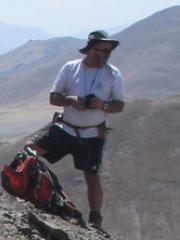
Researcher biography
Professor Jonathan C. Aitchison School of the Environment, University of Queensland
Jonathan Aitchison is a Professor in the School of the Environment (SENV) at the University of Queensland (UQ), where he leads research at the intersection of plate tectonics, paleontology, and sedimentary geology. Originally from New Zealand, he grew up on an active plate boundary, an environment that inspired his lifelong fascination with the processes that shape Earth's dynamic crust.
Professor Aitchison earned his BSc (Hons) and MSc in geology from the University of Otago, including early fieldwork in Antarctica, before moving to Japan as a Monbusho Scholar at Niigata University. He later completed his PhD at the University of New England (Australia), where he reconstructed the tectonic evolution of the New England Orogen using radiolarian microfossils to date marine successions and constrain major tectonic events. This expertise led to his role as a micropaleontologist on Ocean Drilling Program Expedition 126, investigating intra-oceanic island arc development in the Izu–Bonin–Mariana system.
After completing a Japan Society for the Promotion of Science (JSPS) postdoctoral fellowship at Kochi University, Aitchison joined the University of Sydney in the early 1990s, before moving to the University of Hong Kong (HKU) in 1995. At HKU, he established and led the Tibet Research Group, pioneering studies of the India–Asia collision system—research he has pursued for more than three decades. He served as Head of the Department of Earth Sciences at HKU from 2003 to 2009.
In 2011, Aitchison returned to Australia as the Edgeworth David Chair of Geology and Head of the School of Geosciences at the University of Sydney. In 2015 he shifted to Brisbane to take up Headship of the School of Geography, Planning and Environmental Management at UQ. He oversaw the merger that created the School of Earth and Environmental Sciences, leading this school from 2017 to 2021.
His research continues to span multiple frontiers in Earth Science. He maintains active programs in micropaleontology and tectonics, including the evolution of Early Paleozoic radiolarians and the application of synchrotron microCT imaging to microfossils. His long-standing work on the India–Asia collision integrates field studies in northwestern and northeastern India with broader models of Himalayan–Tibetan orogenesis. He also investigates the Paleozoic tectonics of eastern Gondwana.
Recent projects highlight the breadth of his interests: a groundbreaking study of organic carbon recycling that uncovered "bio-diamonds" in ophiolites of the southwest Pacific, and a collaboration with colleagues at the University of Tokyo examining accreted cherts as potential reservoirs of rare earth elements.
Professor Aitchison's career reflects a commitment to integrating paleontological detail with large-scale tectonic processes, offering new insights into both Earth's past and its critical resources for the future.



